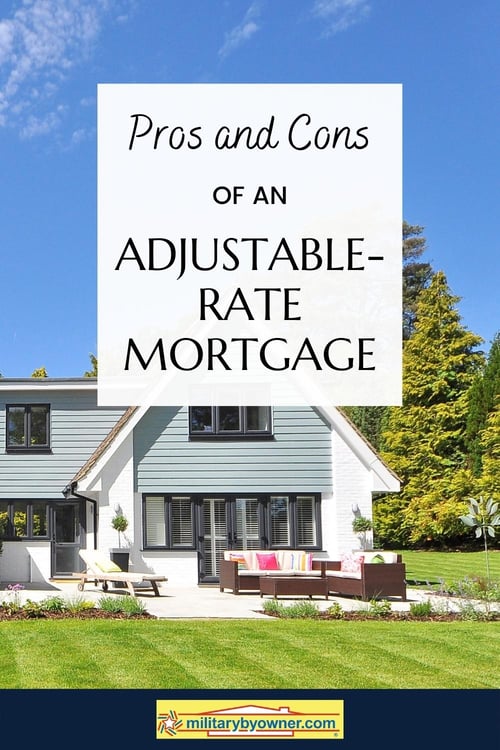Pros & Cons of an Adjustable-Rate Mortgage for Military Homebuyers
Military homebuyers are different from the typical civilian buyer. Most buyers look for a home to move into and live in for the foreseeable future. As a military homebuyer, you know that time in any specific home is probably temporary. This fact alone begs the question: Is an adjustable-rate mortgage (ARM) better than a fixed-rate mortgage (FRM) if you’re a military homebuyer?
Let's explore why the pros of an adjustable-rate mortgage could outweigh the cons for homebuyers in the military community.

Risk Factors of an Adjustable-Rate Mortgage
Fixed-rate mortgages are more favorable among the public because they’re considered low risk. The interest rate remains constant from when you take out the loan, granting you immunity from market fluctuations, which can be great for homebuyers looking for longevity with their new property.
Adjustable-rate mortgages can leave the general population cringing because they’re inherently riskier. With an ARM, you’re at the mercy of the housing market. As it fluctuates, so does your interest rate.
Let’s say you bought a home in 2021 when the average interest rate was a favorable 2.94%. Fast forward to 2022, and rates jumped to around 6.5%. Then, by late 2023 and into 2024, they climbed even higher, peaking at around 7% in some cases. While rates in 2025 have slightly cooled, hovering around 6.75%, they’re still more than double what they were when you locked in your original mortgage rates. That kind of jump is enough to throw off even the most carefully calculated budget.
Another factor that deters many homebuyers from choosing an ARM is the limits associated with it. If your ARM limits how much you can pay on your loan each month, you risk negative amortization.
With a typical home loan, the overall balance gradually reduces each month as you pay your mortgage. But with negative amortization, the effect reverses.
Negative amortization is the gradual increase in the overall amount owed when the buyer can’t keep up with the interest rate. In other words, you fall deeper into debt if you can’t afford to increase your payment to match the rising market.
Sounds scary, right? How does one ensure there’s enough room in the budget to account for drastic fluctuation?
There’s a particular scenario where ARMs assume less risk: if you intend to keep your home for a short duration. It might make sense for military homebuyers who move frequently to consider an ARM, unless you’re buying the property as a rental investment or retiring. Why? Because you’re more likely to dodge heavy swings in the market.
But that’s the tipping point into why an ARM might be a good choice for military homebuyers. Let’s take a closer look.
Potential Benefits of an Adjustable-Rate Mortgage
After covering all the risks, you’re probably wondering what’s left to be desired with an adjustable-rate mortgage? There are a few reasons.
Most banks start an ARM at a lower introductory interest rate since the buyer takes on the risk of future market shifts.
If you plan to own the home for only a few years before selling, you might not even feel much impact from rate fluctuations. Historically, that short window has meant minimal risk, though not zero. The dramatic shifts in 2022 and beyond proved just how fast the market can turn. Interest rates jumped several percentage points in under a year and have remained elevated through 2025. So while a quick buy-and-sell strategy can reduce your exposure, it doesn’t eliminate the risk entirely.
ARMs can be a good option if you know you're selected for promotion.
Since service members' pay is public knowledge, you know what next year's higher pay will be and whether or not you can afford increased mortgage rates. This knowledge should help you avoid negative amortization and growing your debt.
You don’t have to pay to refinance your home to adjust your mortgage rate, unlike FRMs, which have a set rate.
With fixed mortgage rates, if the homeowner wants to lower the interest rate (or overall amount owed), they must pay to refinance. Most home refinances can cost anywhere from 2% to 6% of your new home loan. A $300,000 home would fall anywhere between $6,000 and $18,000.
 Photo by shisuka via Canva.com
Photo by shisuka via Canva.com
Types of Adjustable-Rate Mortgages
There’s more to consider than picking an adjustable-rate mortgage over a fixed-rate one. If you’re leaning toward an ARM, you’ll want to look at what type you’re getting and what kind of cap comes with it. Both factors make a big difference in how much financial risk you’re taking on.
Common ARM Structures
Let’s start with the basics. The most common types of ARMs are:
- 10/1 ARM: Fixed interest rate for 10 years, then adjusts annually.
- 7/1 ARM: Fixed for 7 years, then adjusts annually.
- 5/1 ARM: Fixed for 5 years, then adjusts annually.
The first number indicates how long your rate stays fixed, while the second shows how often it adjusts afterward, typically every year. These are often called hybrid ARMs because they combine a fixed period with a variable one.
Rate Adjustment Caps
To help protect you from drastic jumps, lenders use caps to limit how much your rate can change. These are your built-in guardrails.
- Periodic Adjustment Cap: Limits how much your rate can increase at each adjustment. For example, a 1% periodic cap means your rate can’t rise more than 1% at a time.
- Lifetime Cap: Sets the maximum your interest rate can ever increase over the life of the loan. A 5% lifetime cap means your rate can rise significantly in one year, but it will never increase more than 5% total above the original rate.
Even though a short-term stay in your home might shield you from most of those rate hikes, it’s still wise to know your limits. The past few years have shown us how fast rates can change, and knowing your cap structure can give you peace of mind in an unpredictable market.
Military-Friendly Lenders
Beyond the basic benefits of an ARM, one of the biggest perks for military homebuyers is access to FHA and VA home loans.
Getting a VA loan means enjoying benefits like no down payment, competitive interest rates, and no private mortgage insurance, and you’re also protected from any prepayment penalties if you decide to pay off your loan early.
FHA loans require mortgage insurance, which protects the lender in case you miss payments. While this insurance doesn’t directly lower your interest rate, it often allows lenders to offer better rates for borrowers with less-than-perfect credit.
Neither VA nor FHA loans charge prepayment penalties, so you have the flexibility to pay off your mortgage whenever you want without extra fees. Combining government-backed loans, like the VA loan, with other strategies can help shield military homebuyers from the risks that sometimes come with adjustable-rate mortgages.
 Photo by SDI Productions from Getty Images Signature via Canva.com
Photo by SDI Productions from Getty Images Signature via Canva.com
How to Know if an Adjustable-Rate Mortgage Is Right for You
You need to dig deep into your intentions with the property to determine if an ARM is the right financing option for you.
Consider these three questions before choosing an adjustable-rate mortgage.
1. How long do you plan to own the property?
Although military homebuyers counter some of the risk associated with an ARM with their lifestyle alone, a fixed-rate mortgage might be the better choice if you plan on keeping the property for the foreseeable future. The longer you own the home, the more likely you'll feel the market's fluctuations.
2. What's your Basic Housing Allowance?
Say you live somewhere where Basic Housing Allowance (BAH) is high, such as Hawaii, California, or Washington, DC. Your allowance may cover most or possibly all of the mortgage. But what if you PCS somewhere with a lower BAH? Can you still afford your mortgage if it forces you to pay out-of-pocket more than you might already be?
You can argue that a renter will cover the mortgage, which negates any fluctuation in BAH, but there are some factors to consider with that, which we'll cover in the next point.
3. Do you plan to rent out the property when you PCS?
As stated, longevity is a huge factor when deciding between an ARM and FRM. But let’s say for a minute that you do rent out the home when you move. The goal with a rental investment is to have rent payments at least cover the mortgage payment. But what if your mortgage increases beyond an appropriate rental price? Coupled with the financial risk of an empty rental, higher mortgage rates could have you spending out of pocket.
When an FRM might be better than an ARM:
- If you’re buying a rental investment property.
- You’re buying a home that you plan to retire in.
- You’re unsure whether you want to sell or rent the property when you move.
Another time to pass on an ARM is if you intend to pay off the property within 15 years of owning it. Most ARMs are written for 30 years. If you can afford the higher payments, an FRM should allow you to pay the balance on your loan quicker, accrue less interest, and ultimately save more money.
You can look at the facts until your eyes cross, but it comes down to whether you plan to keep the house for ten years or more and what the housing market is like. While conventional wisdom might say to select a fixed-rate mortgage instead of an adjustable-rate mortgage, consider your circumstances, finances, and intentions.






